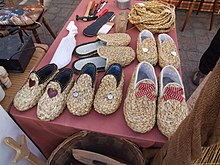Straw shoe
The straw shoe was the traditional footwear of the rural population in the Black Forest . It consists of plaited rye or maize straw and was made in winter by the farmers' wives. Today straw shoes are mainly worn as slippers and for carnival parades .
In order for the straw to be braided, it must be soaked in water for several hours to make it soft and supple. The soft straw is then woven into a kind of rope.
Another area where straw shoes were made is the Hunsrück . There, however, dry straw was woven into straw ropes. These are then the raw material from which the shoes are sewn together.
Manufacturing
As with the production of other shoes too, for shaping a so-called wood is make used. The later size of the straw shoe depends on the size of the last.
The last is covered with a material - usually in several layers - which is used for insulation and to which the braided straw strand is sewn later. The fabric thus forms the lining of the straw shoe. After pulling out the last, a hem made of thin fabric is sewn around the edge of the slip, the so-called embedding.
In order to protect the feet from moisture, a piece of leather - but nowadays also rubber - is sewn onto the underside and pulled up to the sides.
To make a pair of straw shoes you need around 10–12 m of woven straw and around four hours.
Japan
In Japan were Waraji Flechtsandalen mentioned often made from rice straw. In Korea, sandals made of straw are called jipsin .



